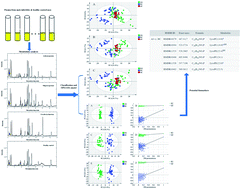Our official English website, www.x-mol.net, welcomes your
feedback! (Note: you will need to create a separate account there.)
Metabolic profiling putatively identifies plasma biomarkers of male infertility using UPLC-ESI-IT-TOFMS†
RSC Advances ( IF 3.9 ) Pub Date : 2018-07-19 00:00:00 , DOI: 10.1039/c8ra01897a F J Zeng 1 , H C Ji 1 , Z M Zhang 1 , J K Luo 2 , H M Lu 1 , Y Wang 2
RSC Advances ( IF 3.9 ) Pub Date : 2018-07-19 00:00:00 , DOI: 10.1039/c8ra01897a F J Zeng 1 , H C Ji 1 , Z M Zhang 1 , J K Luo 2 , H M Lu 1 , Y Wang 2
Affiliation

|
Male infertility has become a global health problem. Currently, the diagnosis of male infertility depends on the results of semen quality or requires invasive surgical intervention. The process is complex and time-consuming. Metabolomics is an emerging platform with unique advantages in disease diagnosis and pathological mechanism research. In this study, ultra-performance liquid chromatography-electrospray ionization-ion trap-time of flight mass spectrometry (UPLC-ESI-IT-TOFMS) combined with chemometrics methods was used to discover potential biomarkers of male infertility based on non-targeted plasma metabolomics. Plasma samples from healthy controls (HC, n = 43) and various types of infertile patients, i.e., patients having oligozoospermia (OS, n = 36), asthenospermia (AS, n = 56) and erectile dysfunction (ED, n = 45) were analyzed by UPLC-ESI-IT-TOFMS. Principal component analysis (PCA) and orthogonal partial least squares discriminant analysis (OPLS-DA) were performed. The results of OPLS-DA showed that HCs could be discriminated from infertile patients including OS (R2 = 0.903, Q2 = 0.617, AUC = 0.992), AS (R2 = 0.985, Q2 = 0.658, AUC = 0.999) or ED (R2 = 0.942, Q2 = 0.500, AUC = 0.998). Some potential biomarkers were successfully discovered by variable selection methods and variable important in the projection (VIP) in combination with the T-test. Statistical significance was set at p < 0.05; the Benjamini–Hochberg false discovery rate was used to reduce type 1 errors resulting from multiple comparisons. The identified biomarkers were associated with energy consumption, hormone regulation and antioxidant defenses in spermatogenesis. To elucidate the pathophysiology of male infertility, relative metabolic pathways were studied. It was found that male infertility is closely related to disturbed phospholipid metabolism, amino acid metabolism, steroid hormone biosynthesis metabolism, metabolism of fatty acids and products of carnitine acylation, and purine and pyrimidine metabolisms. Plasma metabolomics provides a novel strategy for the diagnosis of male infertility and offers a new insight to study pathogenesis mechanism.
中文翻译:

代谢分析推定使用 UPLC-ESI-IT-TOFMS 识别男性不育症的血浆生物标志物†
男性不育已成为一个全球性的健康问题。目前,男性不育症的诊断取决于精液质量的结果或需要侵入性手术干预。该过程复杂且耗时。代谢组学是一个新兴平台,在疾病诊断和病理机制研究方面具有独特优势。本研究采用超高效液相色谱-电喷雾电离-离子阱-飞行时间质谱(UPLC-ESI-IT-TOFMS)结合化学计量学方法,基于非靶向血浆代谢组学发现男性不育的潜在生物标志物。 . 来自健康对照 (HC, n = 43) 和各种类型的不育患者的血浆样本,即患有少精子症 (OS, n= 36)、弱精子症 (AS, n = 56) 和勃起功能障碍 (ED, n = 45) 通过 UPLC-ESI-IT-TOFMS 进行分析。进行了主成分分析(PCA)和正交偏最小二乘判别分析(OPLS-DA)。OPLS-DA结果显示HCs可与不孕症患者区分开来,包括OS(R 2 = 0.903,Q 2 = 0.617,AUC = 0.992),AS(R 2 = 0.985,Q 2 = 0.658,AUC = 0.999)或ED(R 2 = 0.942,Q 2= 0.500,AUC = 0.998)。通过变量选择方法和投影中重要变量(VIP)结合T检验成功发现了一些潜在的生物标志物。统计显着性设置为p< 0.05; Benjamini-Hochberg 错误发现率用于减少多重比较导致的 1 类错误。鉴定出的生物标志物与精子发生过程中的能量消耗、激素调节和抗氧化防御有关。为了阐明男性不育的病理生理学,研究了相关代谢途径。研究发现,男性不育与磷脂代谢紊乱、氨基酸代谢紊乱、甾体激素生物合成代谢紊乱、脂肪酸代谢及肉碱酰化产物紊乱、嘌呤和嘧啶代谢紊乱密切相关。血浆代谢组学为男性不育症的诊断提供了一种新的策略,并为研究发病机制提供了新的视角。
更新日期:2018-07-19
中文翻译:

代谢分析推定使用 UPLC-ESI-IT-TOFMS 识别男性不育症的血浆生物标志物†
男性不育已成为一个全球性的健康问题。目前,男性不育症的诊断取决于精液质量的结果或需要侵入性手术干预。该过程复杂且耗时。代谢组学是一个新兴平台,在疾病诊断和病理机制研究方面具有独特优势。本研究采用超高效液相色谱-电喷雾电离-离子阱-飞行时间质谱(UPLC-ESI-IT-TOFMS)结合化学计量学方法,基于非靶向血浆代谢组学发现男性不育的潜在生物标志物。 . 来自健康对照 (HC, n = 43) 和各种类型的不育患者的血浆样本,即患有少精子症 (OS, n= 36)、弱精子症 (AS, n = 56) 和勃起功能障碍 (ED, n = 45) 通过 UPLC-ESI-IT-TOFMS 进行分析。进行了主成分分析(PCA)和正交偏最小二乘判别分析(OPLS-DA)。OPLS-DA结果显示HCs可与不孕症患者区分开来,包括OS(R 2 = 0.903,Q 2 = 0.617,AUC = 0.992),AS(R 2 = 0.985,Q 2 = 0.658,AUC = 0.999)或ED(R 2 = 0.942,Q 2= 0.500,AUC = 0.998)。通过变量选择方法和投影中重要变量(VIP)结合T检验成功发现了一些潜在的生物标志物。统计显着性设置为p< 0.05; Benjamini-Hochberg 错误发现率用于减少多重比较导致的 1 类错误。鉴定出的生物标志物与精子发生过程中的能量消耗、激素调节和抗氧化防御有关。为了阐明男性不育的病理生理学,研究了相关代谢途径。研究发现,男性不育与磷脂代谢紊乱、氨基酸代谢紊乱、甾体激素生物合成代谢紊乱、脂肪酸代谢及肉碱酰化产物紊乱、嘌呤和嘧啶代谢紊乱密切相关。血浆代谢组学为男性不育症的诊断提供了一种新的策略,并为研究发病机制提供了新的视角。











































 京公网安备 11010802027423号
京公网安备 11010802027423号